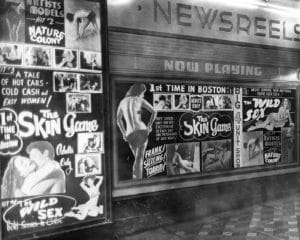
Signs on a building in Boston’s former Combat Zone neighborhood advertise pornographic movies and performances. Photo courtesy of the City of Boston Archives | Mayor John F. Collins records, Collection #0244.001
What: The Combat Zone
When: Nov. 14, 1974
Where: Lower Washington Street, Boston
The Boston Zoning Commission approved a new adult entertainment zone for a two-block area on the edge of Chinatown nearly 50 years ago this month, an area that had become known as the Combat Zone because of its proliferation of crime and adult entertainment businesses.
The zoning district was the city’s strategy to contain the parameters of the red-light district while complying with a U.S. Supreme Court ruling protecting strip clubs and adult entertainment shops under the First Amendment. Boston Redevelopment Authority Director Robert Kenney said the new zoning district would prevent the spread of strip clubs and adult bookstores to other neighborhoods.
After the Government Center urban renewal project demolished a similar red-light district in Scollay Square, the lower Washington Street area emerged as the epicenter of the city’s adult businesses.
“It wasn’t the specific businesses that moved over there. You cut off the supply, but you couldn’t cut off the demand. The people who used to go to Scollay Square simply moved over to the Washington Street area and started to go into the clubs there.”
— Stephanie Schorow, author of “Inside the Combat Zone,” in a 2017 interview with journalist Chris Lovett
To celebrate its 150th anniversary, Banker & Tradesman is highlighting significant moments in the history of Massachusetts’ real estate and banking industries. To suggest a topic, email editorial@thewarrengroup.com.




